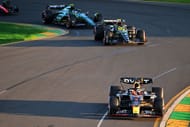It was the 2021 F1 Azerbaijan GP and Max Verstappen's late race crash brought out the red flags. As a result, we had a 2-lap dash to the checkered flag and witnessed a stunning 2-lap sequence.
Lewis Hamilton pressed the 'magic button' and ruined his race. Fernando Alonso stormed through the field and made up multiple places to finish P6. Pierre Gasly fought tooth and nail with Charles Leclerc to secure a podium for AlphaTauri.
Now, Baku is not a place for the light-hearted. The track is narrow, and even in normal race conditions, crashes are just far too common. Getting the tires up to temperature is a concern as well, and so was the fading daylight.
Despite all of these challenges, what we got was an enthralling two-lap sprint that was a resounding success. Fast forward two years and the FIA stewards and race director are under the pump for trying to do the exact same thing in the 2023 F1 Australian GP.

With just a handful of laps left and the race heading for a finish under the safety car, the race director decided to bring out the red flag. It was done in a bid to end the race under green flag conditions.
Well, when the race restarted, what followed was carnage. With drivers trying ridiculous lunges all over the place and struggling with cold tires, it was mayhem.
Multiple cars suffered irrevocable damage and were out of the race and the red flag was brought out again. In all of this, quite a few onlookers questioned a race that featured as many as three red flags. In the end, the cars ultimately did finish the race under the safety car after so much chaos.
In all of this, what has been rather surprising is the all-out attack on FIA officials. So much so that this begs the question of whether the selfish nature of the F1 teams and drivers has turned the FIA officials, be it the race director or the stewards, into a soft target.
Consequences determine opinions

Far too often, we've seen that the consequences of any action on a respective driver or team tend to determine their opinions. One glaring example in Australia was George Russell questioning the first red flag during the race. The first red flag was introduced after Alex Albon's crash.
According to Russell:
"I thought the red flag was totally unnecessary. There was obviously quite a bit of gravel on the track, but there was a clear racing line. We've seen it far worse in the past."
Well, it wasn't. Alex Albon's crash had damaged the barriers and when the race director felt a safety car alone won't do the job, a red flag was introduced.
The red flag was detrimental to George Russell's race, that's for sure, but it wasn't something done to enhance the entertainment factor.
On the contrary, it was supposed to have the opposite impact as a race where drivers were lining themselves up on alternate strategies was now neutralized.
Even Fernando Alonso, who blasted the red flag in Australia because of contact with Carlos Sainz, did not mind the stoppage or the restart in Baku in 2021. Far too many times, drivers and teams have vented their frustration if the race director's call has not gone their way.
At the end of the day, it's for their own selfish gain that every move from the FIA gets a thumbs up or down based on how it impacts them. In all of this, the FIA officials have become easy targets.
At no point do drivers look back at the situation where they could have been at fault as well. The two-lap dash in Baku in 2021 was a success. If it wasn't a success in Australia in 2023, then does all of it comes down to the stewards? It shouldn't!
F1 drivers were shambolic during the restart

It is at this point that we take a look back once again at the second red flag restart that caused such mayhem. It's hard to deny that there were serious challenges that F1 drivers had to overcome. Visibility was a major issue highlighted by Sergio Perez. So was generating tire temperatures at the time.
If we look back at the race in Baku in 2021, the same issues were still present. On that occasion, drivers were able to overcome these challenges. At the end of the day, these are the top 20 driving talents in the world.
You have to expect them to have the racing acumen to overcome the challenges that a late-race F1 restart brings.
What we saw at the race was rightly described by Esteban Ocon as 'suicidal'. We had Carlos Sainz taking out Fernando Alonso. We had Pierre Gasly locking up and going straight on at turn 1.
When he came back on track, he veered right and took out both himself and his teammate in a massive collision. At the back, we had Logan Sargeant mega crash into Nyck de Vries, Yuki Tsunoda dive-bombing Esteban Ocon at Turn 1 and then Lance Stroll going straight on at Turn 3.
The chaos was caused by the F1 drivers and instead of pointing the finger at the FIA, quite a few should have been penalized for their actions.
Yes, there is no argument that the late race Red Flag was primarily brought out to have the race end under green flag conditions. Yes, that decision did increase the risk of possible chaos during the restart.
However, the chaos was not FIA's fault! F1 drivers are equipped enough to overcome these challenges. Their being greedy and locking up while trying to dive-bomb their way through turn 1 is on them and it should be viewed in that light.
FIA not having a spokesperson or talking about this in the media is what makes it susceptible to criticism. Especially if the 10 F1 teams and drivers have microphones in front of them as soon as the race is over.
FIA wasn't perfect and should be consistent

Now, let's get one thing straight. FIA's execution in the 2023 F1 Australian GP was far from perfect. If they were going to penalize Carlos Sainz, they should have penalized Logan Sargeant as well. To add to this, one of the major issues with the FIA is the lack of consistency.
The F1 teams and the drivers were taken by surprise when they found out that the race was going to be red-flagged. Now, in the future, if the FIA is going to go ahead with focussing on a green flag finish, then there needs to be an explicit communication.
F1 teams and drivers should know that a late race crash could mean a red flag and hence if they did, they would be able to prepare themselves for it.
Mercedes boss Toto Wolff made a valid argument when it came to bringing out the safety car. The Austrian said that it was important to have a clear definition of when it was going to be a safety car, a virtual safety car, and a red flag.
If these things are cleared out, teams will be able to prepare themselves better. F1 has undergone many changes in recent times. Some of those changes have been for the better while others have faced resistance.
If the FIA can have a clear stance on race direction and the decisions that will be taken during a certain set of circumstances, then it will help everyone, including F1 fans.
FIA is not perfect. In all fairness, it's shoddy at times as well. But what happened in the second red flag restart was drivers showing poor racecraft.
The blame for the crashes and the carnage should fall on the drivers for their conduct. However, just like everything else in F1, FIA officials were the soft target. Was FIA to blame for the mess created at the end of the 2023 F1 Australian GP? To an extent, yes, but so were the drivers for their conduct.